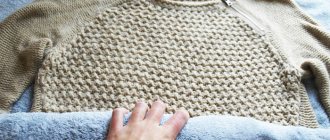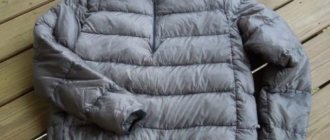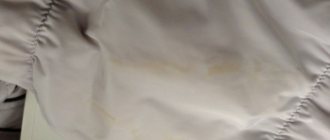Date of publication: 03/09/2017
Let’s clarify right away: shrinkage and felting are different processes, so a thing that has shrunk and felted is not the same thing. Shrinkage is a decrease in linear dimensions; a shrunken sweater becomes shorter and/or narrower. When felting, the qualities of the knitted fabric change: it becomes less elastic, more dense and even rigid, and the structure itself is deformed. Such changes are possible only with natural materials; synthetics, as a rule, retain their original shape. While things made of cotton and linen can also shrink, and not necessarily knitwear, then mostly woolen ones fall. Knitted fabrics shrink more often, no matter whether hand-knitted or machine-knitted, but woven materials can also shrink. Knitted clothes can shrink, but not feel, whereas felted items always shrink.
What to do with a shrunken product?
Woolen sweaters lend themselves well to stretching. Such products can be increased by 1.5-2 sizes.
Features of restoration of woolen products:
- The fibers can be stretched well if you wash the jacket in water with hair rinse. You can also use regular shampoo or fabric conditioner containing lanolin.
- If the jacket needs to be stretched in length, it can be hung on hangers. Under the weight of its own weight, the product will increase in size.
- If only the sleeves of a sweater have shrunk, lay it out to dry on a flat surface. Only the deformed area needs to be pulled.
- The jacket should not be spun in the washing machine at high speed. However, you are allowed to drive off excess water with your hands. This will help it stretch better.
- Only liquid detergents can be used for washing.
- Wool should not be ironed or steamed, even on the reverse side.
All efforts will be wasted if you put the jacket to dry next to the heating device. Under the influence of hot air, the fiber will shrink and the jacket will become small.
Cashmere, tweed and drape sweaters are all types of wool, so you need to care for them in accordance with general recommendations.
If it is not possible to constantly approach and pull a shrunken woolen jacket, after washing it can be spread on a terry towel and secured around the perimeter with pins. They will prevent the fabric from shrinking.
You can stretch a shrunken sweater by treating it with special compounds, such as hydrogen peroxide or vinegar.
When choosing a product, you need to take into account the degree of its aggressiveness. The more delicate the fabric, the more gentle the substance should be.
Not only the treatment of the sweater with certain compounds is important, but also its proper drying.
There is a single instruction that applies to each method:
Do not wring out the product after washing.
The water should drain from it on its own. If you twist a sweater, its fibers will stretch, but unevenly. It is permissible to wrap the item in a terry towel and lightly press it with your palms to absorb excess water.- You need to lay out the sweater on a flat, vertical surface with a towel underneath it. Change it when it gets wet.
- Stretch the sweater while it is wet. The fabric is grabbed with your fingers and pulled apart in different directions. You need to ensure that the tension is even.
You can use unusual methods, for example, hanging several weights from the sweater that will pull it down. Another method to solve the problem is to put the sweater on yourself and wait until it is completely dry. However, walking in a wet jacket for several hours is not entirely comfortable.
Hydrogen peroxide
Hydrogen peroxide weakens the bonds between fabric fibers, so it can be used to increase a sweater by 1 size.
Mode of application:
- 2 tablespoons of peroxide are diluted in 10 liters of water;
- Dip the shrunken jacket into the solution and leave for 3 hours;
- After the specified time, rinse it in cool, clean water.
The product must be dried on a flat surface.
If the sweater is too long, you can hang it on hangers. Under its own weight, its fibers will stretch more.
However, there is a risk of uneven deformation of the tissue. Therefore, it is safest to dry your sweater in a horizontal position.
Turpentine
Turpentine can be used to treat shrunken items.
- Pour 5 liters of cool water into a basin, dissolve 4 tablespoons of turpentine in it.
- Soak the sweater in the prepared mixture and leave for an hour.
- Rinse it thoroughly and lay it out to dry.
Any fabric can be treated with turpentine, but the proportions must be carefully observed. After such washing, the fibers become elastic and soft, so it will be easier to stretch them.
The only drawback of the method is that turpentine has a pungent odor. It may remain on the item even after rinsing it thoroughly. You can deal with it if you leave the sweater in the fresh air for 1-2 days.
When this is not possible, use soda. It is packaged in fabric bags, which are wrapped in a sweater and left inside for several days. Baking soda perfectly absorbs foreign odors.
You can strengthen the recipe if you add 3 tablespoons of ammonia and a tablespoon of cologne or vodka to the solution.
You can deal with shrinkage using vinegar. You need to choose a product with a concentration of 9%.
How to use it:
moisten the fabric with water, avoiding getting it on the seams and collar;- wrap the product in a terry towel to remove excess moisture;
- dissolve 2 tablespoons of vinegar in 250 ml of water and carefully distribute the liquid over the surface of the sweater;
- lay the product on the table and carefully stretch it;
- To fix the result you need to use an iron; steam the sweater through gauze.
This is an effective method that allows you to restore an item by 1-1.5 sizes. Do not iron the sweater directly. This will lead to its damage.
To stretch a natural wool sweater, you can use conditioner or hair rinse.
We invite you to read why things are painted
This method will not harm the product and will give it a pleasant aroma. In this case, it will be possible to stretch the item by 0.5-1 size, but no more.
Mode of application:
- Soak the product in cool water.
- Apply hair rinse to the sweater, evenly saturating the fabric.
- Leave the product for 5 minutes to take effect.
- Pull the fabric in the desired direction.
- Rinse the product and lay it out to dry.
The conditioner makes the fabric soft and delicate, does not lead to the formation of pilling, and helps fluff up the fibers.
Steam treatment
Not every sweater can withstand ironing. A gentle method of stretching it is steam treatment. It is suitable for wool and combination fabrics. The effectiveness of the method is to increase the product by 1 size.
Mode of application:
stuff the sweater with fabric so that its fibers are taut;- You can place one or more pillows inside;
- treat the item with a steam generator around the entire perimeter;
- special attention should be paid to seams;
- You can increase the tension manually.
When steaming is completed, the sweater is left in a taut position until it cools completely. If you immediately remove the stuffing from it, the fibers will return to their original position.
Not everyone has a steam generator in their home. In this case, you can slightly stretch the sweater in another way.
To do this, it is also stuffed with pillows or other suitable filling and left in a room with a high level of humidity, for example, in the bathroom while taking a shower. Under the influence of evaporation, the compressed fibers will straighten slightly.
When are these methods effective?
Traditional methods work well to return shape to shrunken items in the following cases:
- the fabric is knitted from medium or strongly twisted threads;
- wool threads consist of short fibers;
- washing took place at a temperature no higher than 50-60°C, and during rinsing the temperature did not decrease.
The structural protein of wool, keratin, denatures and curls at temperatures above 50 °C, and the “brewed” wool fiber loses its elasticity and ability to return to its previous shape. Therefore, if the knitted fabric was washed in very hot water and felted, it is, alas, impossible to restore its size, structure and appearance.
Subscribe
Subscribe to receive new articles about knitting!
Mechanical and thermal recovery method
You can restore shrunken clothing by mechanically stretching it with your hands or by attaching it to a mannequin of a suitable size.
- You need to start working by soaking the deformed product in warm water for 15-20 minutes.
- After this time, the woolen item is removed from the container and laid out on a wire rack located above the bathtub or basin.
- When the excess liquid has drained, the product is dried a little, wrapped in a terry towel, and then pulled onto the prepared mannequin.
- While the sweater is drying, you need to periodically come up and pull the sleeves and fronts down.
To stretch a wool hat, just soak it in warm water, add a little shampoo or conditioner, and stretch it onto a 3-liter jar. The product will dry and acquire the desired size.
Sometimes the problem can be solved by steaming with an iron. The ironing board is covered with damp gauze. A woolen product is laid out on it, covered with another layer of wet fabric and steamed with an iron. When wet material is heated, a powerful stream of steam is formed, which passes through the wool, slightly pushing the fibers apart.
Why do things sit down and fall off?
Fabric, woven or knitted, consists of threads formed by fibers of raw materials - wool, cotton, flax. These threads have different degrees of twist, and the fibers have different lengths. The more tightly the thread is twisted and the shorter the fibers that make it up, the better the shape of the knitted item is preserved. Conversely, the weaker the twist and the longer the wool fibers, the more shrinkage options are possible. Items made from roving (straight, untwisted wool tape/thread) or long-staple merino yarn shrink the most.
Things shrink and fall off when they are subjected to critical impacts on the threads from which they are knitted, usually due to improper washing. High temperature, alkali plus mechanical action is just what is needed to felt wool. It is this combination of factors that underlies the handmade felting technique; felt is made in the same way. By washing a woolen sweater in a hot, concentrated solution of active detergent, and even using friction (by hand or in a washing machine on gentle programs), you recreate the ideal conditions for the felting process. The fibers of the threads become tangled and firmly adhere to each other - as a result, the fabric becomes uniform and dense. But even during washing without friction (and matting), a woolen item can shrink when the temperature changes, so you need to rinse it in the same warm water as you wash it. Do not forget that when rinsing in an automatic machine, cold water is always used.
The tighter the knitting, the less likely it is that the fabric will shrink. If the item is openwork or loosely knitted, wash it very carefully, since the chance of shrinkage is quite high, the item can decrease by 30% or by half.
How do you return shape to shrunken and matted items?
Traditional methods offer essentially two options. The first is mechanical stretching of the shrunken item to its original size. The nuances of this method differ, but the principle is this: the moistened fabric is pulled in different directions while drying at the same time. Wet wool loses its strength, so if you stretch the thin fabric with all your might, you risk tearing it.
The second option is to act directly on the deformed wool fibers. This includes soaking in solutions of hydrogen peroxide, ammonia, steam treatment or fabric softening agents after washing. The proportions of the solutions are slightly different; their recipes are easy to find on the Internet.
The outer layer of each fiber of wool has the same outer scaly layer as human hair. It is these scales that stick together, starting the stalling process. By using fabric conditioner, we are trying to achieve the same effect that we expect when using hair conditioner: to smooth, glue, and compact the hair scales so that they do not cling to neighboring ones.
Steam also has a gentle effect on the structure of the wool fibers, moisturizing and straightening them, helping to unravel them.
How to iron wool clothes
Woolen items knitted with your own hands usually do not require ironing. It is also not recommended to iron products with a large convex pattern, since under the influence of high temperature and pressure exerted by the sole of the iron on the yarn, the pattern will shrink and lose volume.
However, sometimes it is not possible to do without ironing. In such cases, you must remember that woolen products are ironed only from the inside out and through additional fabric. The iron should be set to the “wool” mode.
You can ruin your favorite woolen item in a few minutes, but it will take more than one hour to restore it. Therefore, when planning to wash a wool sweater, it is better to study the composition of the material in advance and familiarize yourself with the care requirements.
Caring for woolen products must be careful, as they can easily lose their former softness and warmth, and also decrease in size. Since it can be difficult to stretch a woolen item if it has shrunk after washing, you should select the right household chemicals and processing temperature. If a problem arises, simple folk remedies can help.
How to properly wash and dry woolen clothes
Any item made from 100% wool shrinks slightly when washed. This must be taken into account when buying clothes and choose models one size larger. There is another solution to the problem - choosing a product with the addition of synthetic fibers. To preserve all the properties of a pure wool product and at the same time reduce shrinkage, 10-15% polyester or acrylic is added to the material composition.
When washing woolen clothes, you should adhere to the following recommendations:
- Carefully study the manufacturer's information about the composition and care instructions, which is located on the label inside the product or on the yarn packaging.
- Before washing clothes with buttons, it is better to cover the buttonholes. In this case, they will not stretch and no corrections will be required.
- On the washing machine, select the “wool” mode, which provides a water temperature of no more than 30 ° C and turns off the rotation of the drum. If such a mode is not available, you can wash a woolen item in the “delicate” mode, having first turned off the spin cycle.
- Wool cannot withstand an alkaline environment. If you wash clothes made of this material with laundry soap, they will become hard and lose their appearance. To wash woolen products, special gels and powders should be used.
- Items made of wool should not be twisted, as this action can destroy the structure of the fibers. It is better to lay the sweater on a wire rack and wait until the water drains spontaneously. Remaining liquid can be removed with a terry towel.
- Dry woolen items by laying them out on a flat horizontal surface. To prevent the product from shrinking in size when it dries, you can attach the edges with pins. Neither hangers nor radiators should be used for drying.
White woolen items acquire a yellowish tint over time. To return the material to its original whiteness, place half a lemon in a bowl of water and soak the product for 2 hours.











